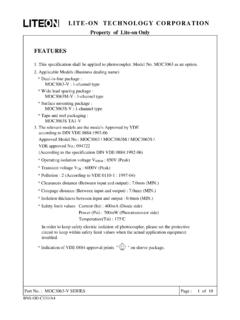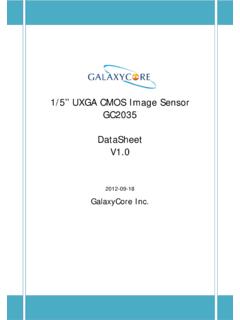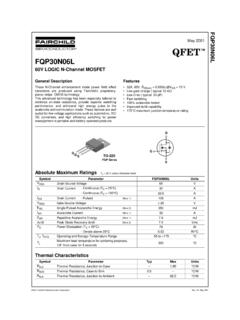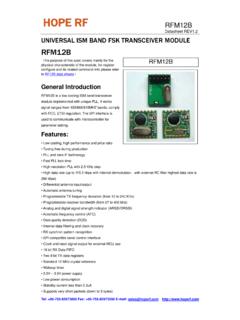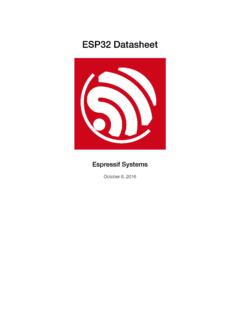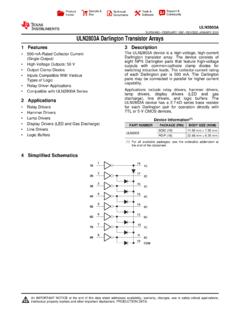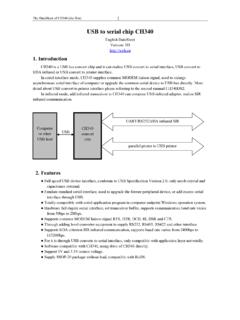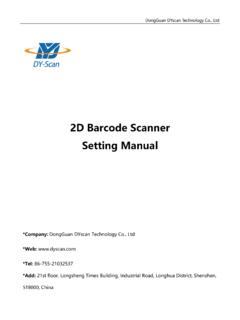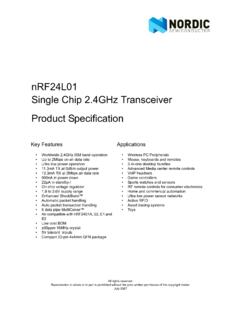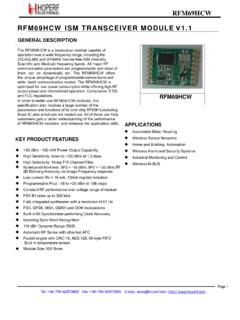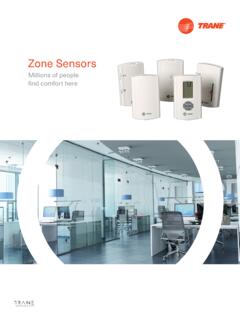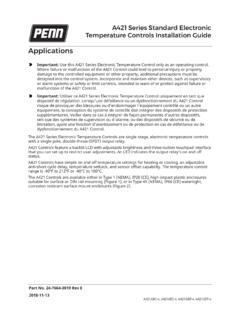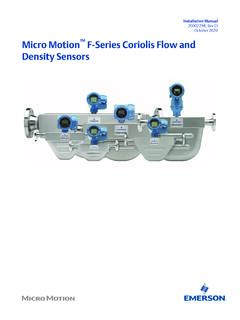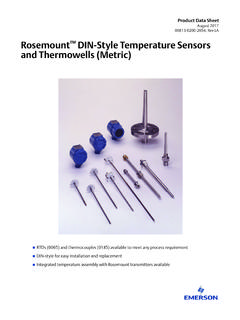Transcription of Programmable Resolution 1-Wire Digital Thermometer
1 1 of 27050400 FEATURES Unique 1-Wire interface requires only oneport pin for communication Multidrop capability simplifies distributedtemperature sensing applications Requires no external components Can be powered from data line. Power supplyrange is to Zero standby power required Measures temperatures from -55 C to+125 C. Fahrenheit equivalent is -67 F to+257 F C accuracy from -10 C to +85 C Thermometer Resolution is programmablefrom 9 to 12 bits Converts 12-bit temperature to Digital word in750 ms (max.) User-definable, nonvolatile temperature alarmsettings Alarm search command identifies andaddresses devices whose temperature isoutside of programmed limits (temperaturealarm condition) Applications include thermostatic controls,industrial systems, consumer products,thermometers, or any thermally sensitivesystemPIN ASSIGNMENTPIN DESCRIPTIONGND - GroundDQ- Data In/OutVDD- Power Supply VoltageNC- No ConnectDESCRIPTIONThe DS18B20 Digital Thermometer provides 9 to 12-bit (configurable) temperature readings whichindicate the temperature of the is sent to/from the DS18B20 over a 1-Wire interface, so that only one wire (and ground)needs to be connected from a central microprocessor to a DS18B20.
2 Power for reading, writing, andperforming temperature conversions can be derived from the data line itself with no need for an externalpower each DS18B20 contains a unique silicon serial number, multiple DS18B20s can exist on thesame 1-Wire bus. This allows for placing temperature sensors in many different places. Applicationswhere this feature is useful include HVAC environmental controls, sensing temperatures inside buildings,equipment or machinery, and process monitoring and Resolution1-Wire Digital 2 3 GNDDQVDD1 2 3 BOTTOM VIEWDS18B20 To-92 Package12348765 NCNCNCGNDNCNCVDDDQDS18B20Z8-Pin SOIC (150 mil)DS18B202 of 27 DETAILED PIN DESCRIPTION Table 1 PIN8 PIN Input/Output pin. For 1-Wire operation: Opendrain. (See Parasite Power section.)33 VDDO ptional VDD pin. See Parasite Power section fordetails of connection. VDD must be grounded foroperation in parasite power (8-pin SOIC): All pins not specified in this table are not to be block diagram of Figure 1 shows the major components of the DS18B20.
3 The DS18B20 has fourmain data components: 1) 64-bit lasered ROM, 2) temperature sensor , 3) nonvolatile temperature alarmtriggers TH and TL, and 4) a configuration register. The device derives its power from the 1-Wirecommunication line by storing energy on an internal capacitor during periods of time when the signal lineis high and continues to operate off this power source during the low times of the 1-Wire line until itreturns high to replenish the parasite (capacitor) supply. As an alternative, the DS18B20 may also bepowered from an external 3 volt - volt to the DS18B20 is via a 1-Wire port. With the 1-Wire port, the memory and controlfunctions will not be available before the ROM function protocol has been established. The master mustfirst provide one of five ROM function commands: 1) Read ROM, 2) Match ROM, 3) Search ROM, 4)Skip ROM, or 5) Alarm Search.
4 These commands operate on the 64-bit lasered ROM portion of eachdevice and can single out a specific device if many are present on the 1-Wire line as well as indicate tothe bus master how many and what types of devices are present. After a ROM function sequence hasbeen successfully executed, the memory and control functions are accessible and the master may thenprovide any one of the six memory and control function control function command instructs the DS18B20 to perform a temperature measurement. The resultof this measurement will be placed in the DS18B20 s scratch-pad memory, and may be read by issuing amemory function command which reads the contents of the scratchpad memory. The temperature alarmtriggers TH and TL consist of 1 byte EEPROM each. If the alarm search command is not applied to theDS18B20, these registers may be used as general purpose user memory. The scratchpad also contains aconfiguration byte to set the desired Resolution of the temperature to Digital conversion.
5 Writing TH, TL,and the configuration byte is done using a memory function command. Read access to these registers isthrough the scratchpad. All data is read and written least significant bit of 27DS18B20 BLOCK DIAGRAM Figure 1 PARASITE POWERThe block diagram (Figure 1) shows the parasite-powered circuitry. This circuitry steals powerwhenever the DQ or VDD pins are high. DQ will provide sufficient power as long as the specified timingand voltage requirements are met (see the section titled 1-Wire Bus System ). The advantages ofparasite power are twofold: 1) by parasiting off this pin, no local power source is needed for remotesensing of temperature, and 2) the ROM may be read in absence of normal order for the DS18B20 to be able to perform accurate temperature conversions, sufficient power mustbe provided over the DQ line when a temperature conversion is taking place. Since the operating currentof the DS18B20 is up to mA, the DQ line will not have sufficient drive due to the 5k pullup problem is particularly acute if several DS18B20s are on the same DQ and attempting to are two ways to assure that the DS18B20 has sufficient supply current during its active conversioncycle.
6 The first is to provide a strong pullup on the DQ line whenever temperature conversions or copiesto the E2 memory are taking place. This may be accomplished by using a MOSFET to pull the DQ linedirectly to the power supply as shown in Figure 2. The DQ line must be switched over to the strong pull-up within 10 s maximum after issuing any protocol that involves copying to the E2 memory or initiatestemperature conversions. When using the parasite power mode, the VDD pin must be tied to method of supplying current to the DS18B20 is through the use of an external power supply tiedto the VDD pin, as shown in Figure 3. The advantage to this is that the strong pullup is not required on theDQ line, and the bus master need not be tied up holding that line high during temperature allows other data traffic on the 1-Wire bus during the conversion time. In addition, any number ofDS18B20s may be placed on the 1-Wire bus, and if they all use external power, they may allsimultaneously perform temperature conversions by issuing the Skip ROM command and then issuing theConvert T command.
7 Note that as long as the external power supply is active, the GND pin may not use of parasite power is not recommended above 100 C, since it may not be able to sustaincommunications given the higher leakage currents the DS18B20 exhibits at these temperatures . Forapplications in which such temperatures are likely, it is strongly recommended that VDD be applied to ROMAND1-WIRE PORTMEMORY ANDCONTROL LOGICSCRATCHPAD8-BIT CRCGENERATORTEMPERATURE SENSORHIGH TEMPERATURETRIGGER, THLOW TEMPERATURETRIGGER, TLCONFIGURATIONREGISTERPOWERSUPPLYSENSEI NTERNAL VDDDQVDDDS18B204 of 27 For situations where the bus master does not know whether the DS18B20s on the bus are parasitepowered or supplied with external VDD, a provision is made in the DS18B20 to signal the power supplyscheme used. The bus master can determine if any DS18B20s are on the bus which require the strongpullup by sending a Skip ROM protocol, then issuing the read power supply command.
8 After thiscommand is issued, the master then issues read time slots. The DS18B20 will send back 0 on the1-Wire bus if it is parasite powered; it will send back a 1 if it is powered from the VDD pin. If themaster receives a 0, it knows that it must supply the strong pullup on the DQ line during temperatureconversions. See Memory Command Functions section for more detail on this command PULLUP FOR SUPPLYING DS18B20 DURING TEMPERATURECONVERSION Figure 2 USING VDD TO SUPPLY TEMPERATURE CONVERSION CURRENT Figure 3 P+3V - + +3V - + PDS18B20 VDDI/O+3V - + +3V - + OTHER1-WIREDEVICESDS18B205 of 27 OPERATION - MEASURING TEMPERATUREThe core functionality of the DS18B20 is its direct-to- Digital temperature sensor . The Resolution of theDS18B20 is configurable (9, 10, 11, or 12 bits), with 12-bit readings the factory default state. Thisequates to a temperature Resolution of C, C, C, or C.
9 Following the issuance ofthe Convert T [44h] command, a temperature conversion is performed and the thermal data is stored inthe scratchpad memory in a 16-bit, sign-extended two s complement format. The temperatureinformation can be retrieved over the 1-Wire interface by issuing a Read Scratchpad [BEh] commandonce the conversion has been performed. The data is transferred over the 1-Wire bus, LSB first. TheMSB of the temperature register contains the sign (S) bit, denoting whether the temperature is positiveor 2 describes the exact relationship of output data to measured temperature. The table assumes 12-bitresolution. If the DS18B20 is configured for a lower Resolution , insignificant bits will contain zeros. ForFahrenheit usage, a lookup table or conversion routine must be Relationships Table 2232221202-12-22-32-4 LSBMSb(unit = C)LSbSSSSS262524 MSBTEMPERATUREDIGITAL OUTPUT(Binary)DIGITALOUTPUT(Hex)+125 C0000 0111 1101 000007D0h+85 C0000 0101 0101 00000550h*+ C0000 0001 1001 00010191h+ C0000 0000 1010 001000A2h+ C0000 0000 0000 10000008h0 C0000 0000 0000 C1111 1111 1111 C1111 1111 0101 C1111 1110 0110 1111FF6Fh-55 C1111 1100 1001 0000FC90h*The power on reset register value is +85 - ALARM SIGNALINGA fter the DS18B20 has performed a temperature conversion, the temperature value is compared to thetrigger values stored in TH and TL.
10 Since these registers are 8-bit only, bits 9-12 are ignored forcomparison. The most significant bit of TH or TL directly corresponds to the sign bit of the 16-bittemperature register. If the result of a temperature measurement is higher than TH or lower than TL, analarm flag inside the device is set. This flag is updated with every temperature measurement. As long asthe alarm flag is set, the DS18B20 will respond to the alarm search command. This allows manyDS18B20s to be connected in parallel doing simultaneous temperature measurements. If somewhere thetemperature exceeds the limits, the alarming device(s) can be identified and read immediately withouthaving to read non-alarming of 2764-BIT LASERED ROMEach DS18B20 contains a unique ROM code that is 64-bits long. The first 8 bits are a 1-Wire familycode (DS18B20 code is 28h). The next 48 bits are a unique serial number.
